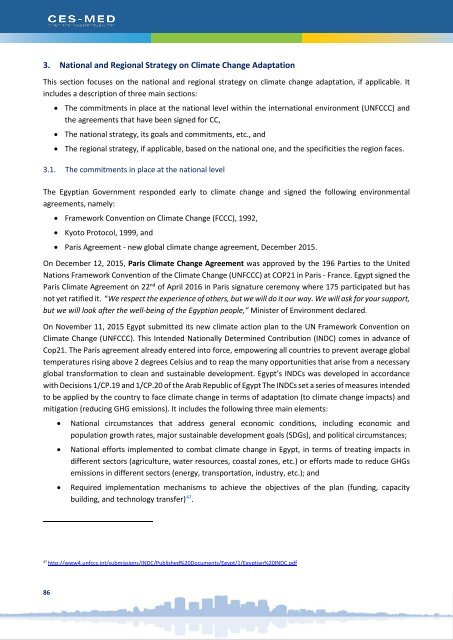280218_Luxor-Egypt SECAP Final_revised
Create successful ePaper yourself
Turn your PDF publications into a flip-book with our unique Google optimized e-Paper software.
3. National and Regional Strategy on Climate Change Adaptation<br />
This section focuses on the national and regional strategy on climate change adaptation, if applicable. It<br />
includes a description of three main sections:<br />
• The commitments in place at the national level within the international environment (UNFCCC) and<br />
the agreements that have been signed for CC,<br />
• The national strategy, its goals and commitments, etc., and<br />
• The regional strategy, if applicable, based on the national one, and the specificities the region faces.<br />
3.1. The commitments in place at the national level<br />
The <strong>Egypt</strong>ian Government responded early to climate change and signed the following environmental<br />
agreements, namely:<br />
• Framework Convention on Climate Change (FCCC), 1992,<br />
• Kyoto Protocol, 1999, and<br />
• Paris Agreement - new global climate change agreement, December 2015.<br />
On December 12, 2015, Paris Climate Change Agreement was approved by the 196 Parties to the United<br />
Nations Framework Convention of the Climate Change (UNFCCC) at COP21 in Paris - France. <strong>Egypt</strong> signed the<br />
Paris Climate Agreement on 22 nd of April 2016 in Paris signature ceremony where 175 participated but has<br />
not yet ratified it. “We respect the experience of others, but we will do it our way. We will ask for your support,<br />
but we will look after the well-being of the <strong>Egypt</strong>ian people,” Minister of Environment declared.<br />
On November 11, 2015 <strong>Egypt</strong> submitted its new climate action plan to the UN Framework Convention on<br />
Climate Change (UNFCCC). This Intended Nationally Determined Contribution (INDC) comes in advance of<br />
Cop21. The Paris agreement already entered into force, empowering all countries to prevent average global<br />
temperatures rising above 2 degrees Celsius and to reap the many opportunities that arise from a necessary<br />
global transformation to clean and sustainable development. <strong>Egypt</strong>’s INDCs was developed in accordance<br />
with Decisions 1/CP.19 and 1/CP.20 of the Arab Republic of <strong>Egypt</strong> The INDCs set a series of measures intended<br />
to be applied by the country to face climate change in terms of adaptation (to climate change impacts) and<br />
mitigation (reducing GHG emissions). It includes the following three main elements:<br />
• National circumstances that address general economic conditions, including economic and<br />
population growth rates, major sustainable development goals (SDGs), and political circumstances;<br />
• National efforts implemented to combat climate change in <strong>Egypt</strong>, in terms of treating impacts in<br />
different sectors (agriculture, water resources, coastal zones, etc.) or efforts made to reduce GHGs<br />
emissions in different sectors (energy, transportation, industry, etc.); and<br />
• Required implementation mechanisms to achieve the objectives of the plan (funding, capacity<br />
building, and technology transfer) 47 .<br />
47<br />
http://www4.unfccc.int/submissions/INDC/Published%20Documents/<strong>Egypt</strong>/1/<strong>Egypt</strong>ian%20INDC.pdf<br />
86

















